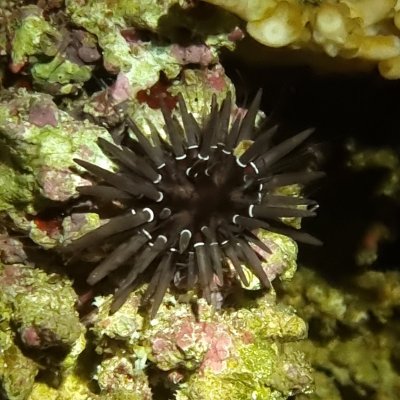Navigation
Install the app
How to install the app on iOS
Follow along with the video below to see how to install our site as a web app on your home screen.
Note: This feature may not be available in some browsers.
More options
You are using an out of date browser. It may not display this or other websites correctly.
You should upgrade or use an alternative browser.
You should upgrade or use an alternative browser.
Urchin id please
- Thread starter PeterEde
- Start date
- Tagged users None
IMHO, I believe it's a pencil urchin. I have a couple of rock boring urchins and they don't have the white band at the base of the spines.
The white rings at the base of the spines are super distinctive - to my current knowledge, your specimen could only be either an Echinometra species, Parasalenia gratiosa, or (sometimes) Heterocentrotus mamillatus.
For the colors your urchin has, H. mamillatus (the Red Slate Pencil Urchin) is extremely unlikely, so that leaves either an Echinometra species or P. gratiosa. An easy way to distinguish adult P. gratiosa from adults of Echinometra species like E. mathaei or E. oblonga is size: if the urchin is bigger than ~3.5cm, it's an Echinometra. The other easy way to distinguish is by looking at the periproct plates (the "teeth" around the urchin's anus); P. gratiosa will only have 3-5 periproct plates while an Echinometra species will have a bunch (for examples, see the links below; the second pic of the Lizard Island Guide shows P. gratiosa's periproct plates, and figure 8 from the Semantic Scholar link shows the periproct of E. mathaei - it's a lot harder to see the periproct of E. mathaei clearly on live specimens, but they also have a pic of the area in figure 1). The French Wikipedia page lists some more subtle differences, but the methods above would be my suggestion for differentiating them.
Edit: Forgot to add the French Wikipedia link:

 fr.wikipedia.org
All that said, Echinometra species are reportedly much more common, so I'd assume that's what you have.
fr.wikipedia.org
All that said, Echinometra species are reportedly much more common, so I'd assume that's what you have.
Regardless, P. gratiosa is reportedly a primarily herbivorous detritivore (though it may - like pretty much all urchins - occasionally eat sedentary inverts), while Echinometra species are reportedly herbivores, so both would be good for a tank. Echinometra species are rock-boring, while P. gratiosa seems to basically go wherever it wants.
For the colors your urchin has, H. mamillatus (the Red Slate Pencil Urchin) is extremely unlikely, so that leaves either an Echinometra species or P. gratiosa. An easy way to distinguish adult P. gratiosa from adults of Echinometra species like E. mathaei or E. oblonga is size: if the urchin is bigger than ~3.5cm, it's an Echinometra. The other easy way to distinguish is by looking at the periproct plates (the "teeth" around the urchin's anus); P. gratiosa will only have 3-5 periproct plates while an Echinometra species will have a bunch (for examples, see the links below; the second pic of the Lizard Island Guide shows P. gratiosa's periproct plates, and figure 8 from the Semantic Scholar link shows the periproct of E. mathaei - it's a lot harder to see the periproct of E. mathaei clearly on live specimens, but they also have a pic of the area in figure 1). The French Wikipedia page lists some more subtle differences, but the methods above would be my suggestion for differentiating them.
species: Parasalenia gratiosa in taxonomy (Lizard Island Field Guide)
lifg.australian.museum

Parasalenia gratiosa — Wikipédia
Regardless, P. gratiosa is reportedly a primarily herbivorous detritivore (though it may - like pretty much all urchins - occasionally eat sedentary inverts), while Echinometra species are reportedly herbivores, so both would be good for a tank. Echinometra species are rock-boring, while P. gratiosa seems to basically go wherever it wants.
Black/Oblong Rock-boring Urchin - Echinometra oblonga; it could also be the Burrowing Urchin, E. mathaei, as the two are similar enough that E. oblonga was once considered a morph of E. mathaei,* but - based on the coloration of your specimen - E. oblonga seems more likely to me.
Either way, both species primarily reside in the rocks and primarily feed on turf algae of various kinds** - so a good herbivore for your tank.
*Source:
**Source:Echinometra oblonga - Plazi TreatmentBank
treatment.plazi.org
I does look flatter than other urchins I have. 5 in all and all hitchhikers
Similar threads
New Posts
-
-
-
-
-
SPONSOR Livestock Mythical corals Bounce Electus 20% off 1 left!
- Latest: Camaro Show Corals















